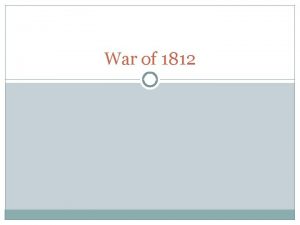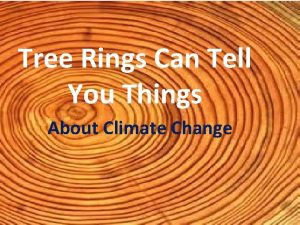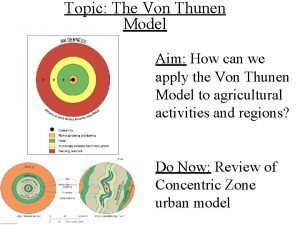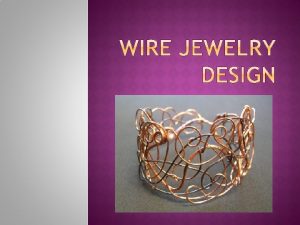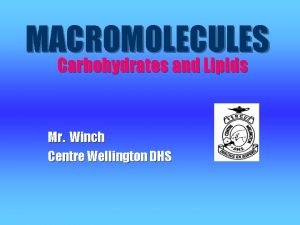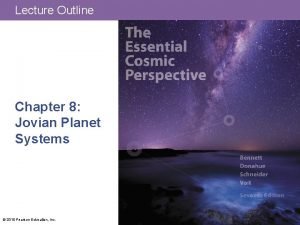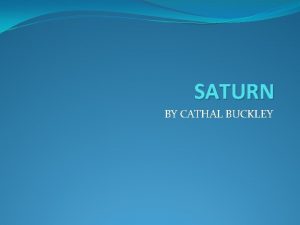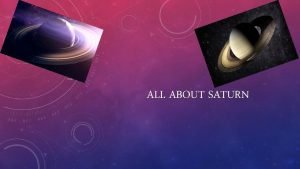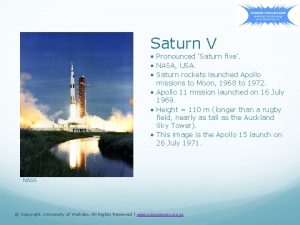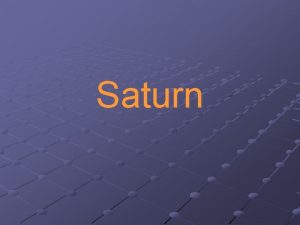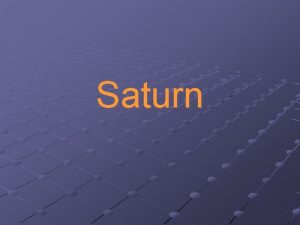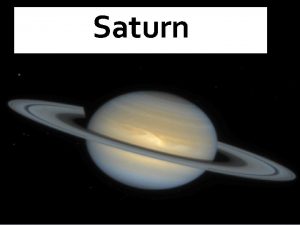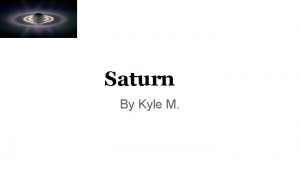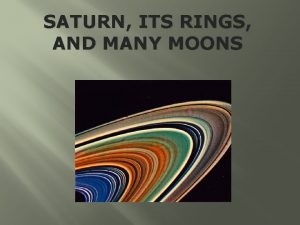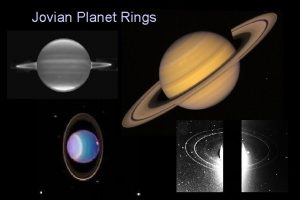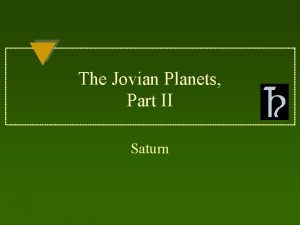SATURN History The rings of Saturn was first











- Slides: 11

SATURN

History • The rings of Saturn was first observed by Galileo Galilei in 1610 • Described Saturn as having "ears. " • In 1612 the plane of the rings was leaning directly at the Earth and the rings appeared to disappear, and then in 1613 they reappeared again, further puzzling Galileo.

History Continuation • The riddle of the rings was not solved until 1655 by Christiaan Huygens, using a telescope much more powerful than the ones available to Galileo in his time. • In 1675 Giovanni Dominique Cassini gritty that Saturn's ring was really poised of multiple smaller rings with gaps between them; the prime of these gaps was later named the Cassini Division.

SATURN • The sixth planet from the Sun. • The second largest planet in the Solar System • Saturn has large rings consisting of mostly ice particles with a smaller amount of rocky debris. • Named after the Roman titan, Saturnus(Kronos in Greek)

Revolution Period ` 29. 46 years (10752. 9 days) Rotation Period 0. 43 days Rotaional Velocity: 37, 004. 9 km/hr

Length of Day Length of a Year 10 hours, 39 minutes 29. 5 Earth years in Earth time

SATURN Atmosphere Composition: 97% Hydrogen, 3% Helium and 0. 05% of Ammonia Density: 0. 69 g/cm³ Diameter: 120, 536 kilometers Distance from Sun: 1, 429, 400, 000 km Gravity: 9. 05 m/s² Mass: 5. 69 E+26 kg Temperature: -130 º C Axis Tilt: 25. 33 º

Sattelites Name Saturn's major satellites, compared to Earth's Moon Orbital Diameter Mass Orbital radius period (km) (kg) (km) (days) Mimas Enceladus Tethys Dione 400 0. 4× 1020 185, 000 (12% Moon) (0. 05% Moon) (50% Moon) 0. 9 (3% Moon) 500 (14% Moon) 1, 070 (30% Moon) 1. 4 (5% Moon) 1. 9 (7% Moon) 1. 1× 1020 (0. 2% Moon) 6. 2× 1020 (0. 8% Moon) 1, 120 11× 1020 (32% Moon) (1. 5% Moon) 238, 000 (60% Moon) 295, 000 (80% Moon) 2. 7 377, 000 (10% Moo (100% Moon) n)

Name Diameter (km)[ Mass (kg) Orbital radius (km) Orbital period (days) Rhea 1, 530 527, 000 20 23× 10 (44% Moo (140% Mo (3% Moon) n) on) 4. 5 (20% Moo n) Titan 5, 150 1, 350× 1020 1, 222, 000 (148% Mo (180% Mo (320% Mo on) on) (75% Mars) 16 (60% Moo n) Iapetus 1, 470 18× 1020 3, 560, 000 79 (42% Moo (2. 5% Moo (930% Mo (290% Mo n) n) on)

Did you know… • The satellite Titan is the largest satellite of Saturn? It is bigger than planet Mercury • The temperature at Saturn’s cloud tops -139°C or 218°F? • That Saturn’s rings are made of billions of ice particle?

 Why does saturn have rings
Why does saturn have rings Joslin class rings
Joslin class rings What two things do tree rings indicate
What two things do tree rings indicate Von thunen model rings explained
Von thunen model rings explained Membranes and ligaments of larynx
Membranes and ligaments of larynx Plot diagram for the outsiders
Plot diagram for the outsiders Circles of hell
Circles of hell Personal ornaments such as necklaces, rings, or bracelets.
Personal ornaments such as necklaces, rings, or bracelets. Movie poster codes and conventions
Movie poster codes and conventions Sharroky hollie rings of culture
Sharroky hollie rings of culture Lipids made up of rigid carbon rings
Lipids made up of rigid carbon rings Why do jovian planets have rings
Why do jovian planets have rings
